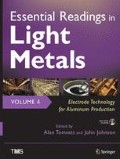Abstract
The quality of calcined petroleum coke used in primary aluminum production is affected by each of the refining and calcining processes including choice of crude, many of the initial refinery processing steps, coking, calcining as well as the handling systems between the refinery, calciner and final customer. This paper will discuss how each of these processes affects the final quality of the resulting calcined coke to give insight as to how refining economics will be affecting calcined coke quality in the future.
Access this chapter
Tax calculation will be finalised at checkout
Purchases are for personal use only
Preview
Unable to display preview. Download preview PDF.
References
Hume, S.M., “Influence of Raw Material Properties on the Reactivity of Carbon Anodes Used in the Electrolytic Production of Aluminium” (Doctoral Thesis), Aluminium-Verlag, February (1993).
Muftuoglu, T., Fernandez, R., “The Effects of Feedstock and Coke Calcination Degree on the Properties of Bench-Scale Anodes,” Light Metals, p. 511 (1990)
Belitskus, D.L., “Effects of Petroleum Coke Calcination Temperature and Anode Baking Temperature on Anode Properties,” Light Metals, p. 557–564 (1991)
Hardin, E.E., Ellis, P.J., Beilharz, C.L., McCoy, L., “A Comprehensive Review of the Effects of Calcination at Various Temperatures on Coke Structure and Properties, Part II,” Light Metals, p.571–582 (1994)
Ellis, P.J., Bacha, J.D., “Shot Coke,” Light Metals, p. 477 (1996)
Rhedey, P.J., Nadkarni, S.K., “Coker Feedstock Characteristics and Calcined Coke Properties,” Light Metals, p. 859–868 (1984)
Mannweiler, U., Rodriguez, D., Schmidt-Hatting, W., Maitland, A., “High Vanadium Venezuelan Petroleum Coke, A Rawmaterial for the Aluminum Industry?” Light Metals, p. 447–454 (1989)
Elliott, J.D., “Maximize Distillate Liquid Products,” Hydrocarbon Processing, p. 75, January (1992).
Wong, D.K., Ellingsen, R.P., Vitchus, B.C., Bustamante, C., Mladenik, J.L., United States Patent No. 5,520,795, May 28, 1996.
Hoang, Y.K., Vitchus, B. “Laboratory Studies on the impact of Vanadium and Sodium on the Air Reactivity of Coke and Anodes,” Fifth Australasian Aluminum Smelter Technology Workshop, p. 430–446, October (1995)
Rhedey, P., “Structural Changes in Petroleum Coke During Calcination,” Transactions of the Metallurgical Socity of AIME, 239, p. 1084–1091, July (1967)
Jones, S. S., Hildebrandt, R. D., “Green Coke Volatile Emission Spectra,” Light Metals, AIME, p. 423–440 (1981)
Voigt, M.F., Jones, G.R., Tyler, G.A., “The Use of Refractory Tumblers in Coke Calcination,” Light Metals, p. 1697–1714 (1984)
Hardin, E.E., Ellis, P., Dickie, R.C., Beilharz, C.L., “Calcining and Delayed Coking Technology to Produce Anode Grade Petroleum Coke,” Australian Smelting Workshop, p. 171–191 (1992)
Nowak, T.G., Crisp, R.W., “Raw Material Blending Systems in Petroleum Coke Calcining Operations,” Light Metals, p. 571–582 (1994)
Coste, B., Schneider, J.P., “Influence of Coke Real Density on Anode Reactivity Consequence on Anode Baking,” Light Metals, p. 583–591 (1994)
Garbarino, R.M., Brown, R.J., Vogt, M.F., Vogt, S.A., “Particle Degradation During Coke Handling,” Light Metals, p. 545 (1995)
Martin, T.W., “Global Refining Addresses Increased Oil Demands, New Challenges,” Oil & Gas Journal, p. 51, March 16 (1998)
Reuters news Release, “SPR Release receives mixed interest from oil companies,” October 3, 2000.
Author information
Authors and Affiliations
Editor information
Editors and Affiliations
Rights and permissions
Copyright information
© 2016 The Minerals, Metals & Materials Society
About this chapter
Cite this chapter
Vitchus, B., Cannova, F., Childs, H. (2016). Calcined Coke from Crude Oil to Customer Silo. In: Tomsett, A., Johnson, J. (eds) Essential Readings in Light Metals. Springer, Cham. https://doi.org/10.1007/978-3-319-48200-2_1
Download citation
DOI: https://doi.org/10.1007/978-3-319-48200-2_1
Publisher Name: Springer, Cham
Print ISBN: 978-3-319-48577-5
Online ISBN: 978-3-319-48200-2
eBook Packages: Chemistry and Materials ScienceChemistry and Material Science (R0)

